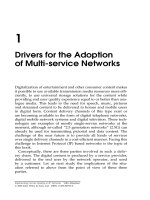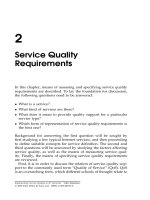Thực hiện chất lượng dịch vụ trong các mạng IP (P1)
Bạn đang xem bản rút gọn của tài liệu. Xem và tải ngay bản đầy đủ của tài liệu tại đây (87.3 KB, 8 trang )
1
Drivers for the Adoption
of Multi-service Networks
Digitalization of entertainment and other consumer content makes
it possible to use available transmission media resources more effi-
ciently, to use universal storage solutions for the content while
providing end user quality experience equal to or better than ana-
logue media. This leads to the need for speech, music, pictures
and streamed content to be delivered to homes and mobile users
in digital form. Content delivery channels of this type exist or
are becoming available in the form of digital telephone networks,
digital mobile network systems and digital television. These tech-
nologies are examples of mostly single-service networks at the
moment, although so-called “2.5 generation networks” (2.5G) can
already be used for transmitting pictorial and data content. The
challenge of the near future is to provide all kinds of services
over single delivery channels in a cost-efficient manner. Facing this
challenge in Internet Protocol (IP) based networks is the topic of
this book.
Conceptually, there are three parties involved in such a deliv-
ery chain. The digital content is produced by a service provider,
delivered to the end user by the network operator, and used
by a customer. Let us next study the implications of the situ-
ation referred to above from the point of view of these three
parties.
Implementing Service Quality in IP Networks Vilho R
¨
ais
¨
anen
2003 John Wiley & Sons, Ltd ISBN: 0-470-84793-X
2 DRIVERS FOR THE ADOPTION OF MULTI-SERVICE NETWORKS
In this section, only the access network operator viewpoint is
considered. We shall return to the interrelations of access and
backbone network operators later in this book.
1.1 CUSTOMER PERSPECTIVE
Currently, a home user is typically using multiple access technolo-
gies for communication. Wireline telephony (“Plain Old Telephony
System, POTS”) and cellular phones are used for two-way speech
delivery. Digital cellular phones also support text and picture
form messaging. Broadcast TV and radio are used for receiving
audio and video content such as news and entertainment. Usage
may be associated with a “flat-rate” subscription for the service or
be free of charge. Cable TV infrastructure may be used as a trans-
mission medium for paid audio and video content, in addition to
being used for the distribution of broadcast programs. Paid con-
tent may be billed based on flat-rate subscription or usage-based.
Internet access can be handled via POTS local loop, Integrated
Subscriber Digital Network (ISDN) over POTS, some variant
of Digital Subscriber Line (xDSL), or a cable modem. Recent
additions to the repertoire include wireless broadband access
using meshed wireless routers or Wireless Local Area Networks
(WLAN). Each of these technologies is associated with a delivery
channel, as illustrated in Figure 1.1.
Internet
PSTN
Broadcast content
TV set
PC
Telephone
Figure 1.1 Service delivery via multiple access channels
1.1 CUSTOMER PERSPECTIVE 3
A noteworthy aspect of this situation is that the reception of
different service types is based on different kinds of technology:
POTS telephony and broadcast TV/radio are based on analogue
technology, whereas Internet access and cellular telephony (in
Europe and increasingly in other continents as well) is based on
digital technologies. Thus, the home user currently needs a POTS
telephone, radio receiver, TV receiver, radio receiver, cable TV set-
top box, personal computer (PC), and xDSL Customer Premise
Equipment (CPE). The mere existence of different kinds of equip-
ment is no bad thing as such; it is often good to use equipment
specifically designed for one service to have optimal usage expe-
rience. What is not optimal is the inability to receive all types of
content in a single type of device, say, PC, if need be.
Second, with the exception of telephony and Internet use, the
services are typically one-way “broadcast” type of services with
an associated usage fee. This arrangement is rather inflexible; a
subscriber of such a service pays for all types of content and not
only the types the subscriber is interested in. Also, the selection of
the content “on-demand” basis is highly desirable. Digital TV is
now taking its first steps in Europe. Digital TV technologies allow
for interactivity to complement the distribution of the content over
the digital TV channel. This is a step in the right direction.
Third, the traditional arrangement ties the end user to a single
“access network” provider who is also the service provider.
Competition for the local loop access has not always succeeded
optimally. Thus, for each of the access technologies, the customer
has to pay a price that is not determined by competition in
a free market.
Fourth, messaging-type services have become popular recently,
allowing users to send notices to other users in near-instant fash-
ion. In addition to “traditional” e-mail, other examples of mes-
saging include the Short Message Service (SMS) and the Multi-
media Message Service (MMS) of GSM/GPRS (Group
´
eSp
´
ecial
Mobile/General Packet Radio Service) networks, and messaging
on the Internet. Such messaging requires that users are “on-line”
in order to receive messages addressed to them. In addition to
telephone networks, this is possible for Internet messaging using
xDSL and with the communication endpoint (PC) switched on.
Collecting some of the observations made so far, a wish
list of the customer for information access technology would
look as follows.
4 DRIVERS FOR THE ADOPTION OF MULTI-SERVICE NETWORKS
• Communication endpoints (e.g. PC, mobile terminals) should
support accessing of different kinds of services. Dedicated termi-
nals such as TV sets can be used when optimal usage experience
or storing of received content is important.
• Converged access network systems should support the delivery
of all kinds of services. The same network should support deliv-
ery of messaging, data, and streamed content as well as being
suitable for supporting conferencing-type applications.
• The end-to-end delivery chain should make it possible to
separate provision of services from provision of access to
services. This allows the choice of the most adequate access
technology according to the usage situation. Specific details of
the access medium should be as invisible to the user of the
service as possible.
• Interactivity should be possible, in addition to receiving
broadcast or downloaded content. Specifically, support for near-
instant messaging is highly desirable.
1.2 NETWORK OPERATOR PERSPECTIVE
The business need fulfilled by the network operator is to pro-
vide access to service types for the customer. Depending on access
technology, the competition is more or less fierce. In copper local
loops, for example, incumbent network providers are challenged
by new entrants, cable modems, and wireless access technolo-
gies. In cellular networks, to take another example, most countries
have multiple operators. Due to competition, operators need to
consider both capital expenditure (CAPEX) and operating expen-
ditures (OPEX) of their network technology platform. In brief,
CAPEX considerations lead to the goal of utilizing built capac-
ity as efficiently as possible, whereas OPEX aspects boil down to
streamlining and automatization of technological solutions in use.
Both of these aspects will be discussed in this book.
The progress of content digitalization, the advent of new ser-
vices, and expectations of interactivity and converged technology
platforms pose further challenges to the access network operators.
It is in the interest of operators to develop technological platform
support for advanced service types.
1.2 NETWORK OPERATOR PERSPECTIVE 5
The convergence of the multi-service network has been a
technological goal of the telecommunications industry for a long
time. One of the first attempts was narrowband ISDN (Integrated
Services Digital Network), supporting up to eight ISDN terminals
within the customer’s premises and providing two simultaneous
circuit-switched connections from a single ISDN CPE using ISDN’s
2D + B channel technology. Alas, business adoption of ISDN
occurred fairly late, in Europe during the latter half of the 1990s. In
ISDN, the bit rate of a single channel was limited to 64 or 56 kbit/s
because of the (Analogue/Digital) A/D conversion used in digital
POTS network.
The next attempt was broadband ISDN, also known as Asyn-
chronous Transfer Mode (ATM). ATM has advanced multi-service
capabilities and can support high bit rates. As a result of a long-
drawn standardization effort, the final ATM standard is fairly
complex, and failed to be implemented end-to-end. An issue that
became evident after taking ATM into production use, the man-
agement of ATM networks is complicated. In addition to manag-
ing the ATM network as such, the operator also needs to man-
age the protocol layers below (for example, Synchronous Digital
Hierarchy, SDH) and above (for example, Internet Protocol, IP)
ATM. Subsequently, in the Internet domain ATM is mostly used
in backbone networks where the configuration is often static.
In the late 1990s, it turned out that the winning convergence
layer was IP. The main reasons for it being victorious stem from
existing wide-scale adoption of the technology in the Internet and
IP not being “owned” by a only a handful of vendors. In Internet
design philosophy, the state is maintained at the communica-
tion endpoints and not in the network, allowing for cost-efficient
design of networking equipment. IP is a good convergence layer in
the sense that it can be run over multiple link layer technologies,
including ATM. On the applications side, the Internet Engineering
Task force has developed – and keeps on developing – a rich set
of protocols for interfacing different kinds of service applications
to IP using “Layer four” (L4) protocols such as Transfer Control
Protocol (TCP) and User Datagram Protocol (UDP). In particu-
lar, the standard socket programming interface towards IP and
multiplexing protocols such as TCP and UDP is well known.
The adoption of IP in different Internet access networks together
with the rapid growth of Internet usage has brought with it very
rapid growth of traffic volumes in the network. At the time of









